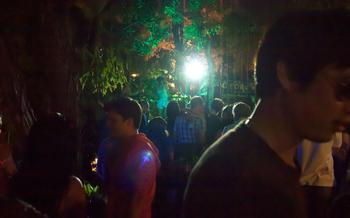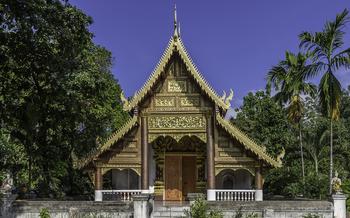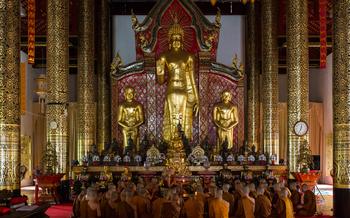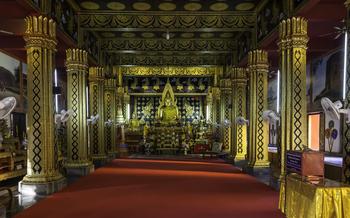
Hua Na Temple
- The History of Hua Na Temple
- Finding the Location of the Hua Na Temple
- The Importance of the Hua Na Temple
- The Temple Grounds
- The Main Temple Building
- The Surrounding Complex
- The Temple's Atmosphere
- Visitor Tips: What to Respect
- Things to Do at Hua Na Temple
- Taking a Break from Sightseeing
- Exploring the Area Around the Temple
- The Best Time to Visit the Hua Na Temple
- The Hua Na Temple Festival
- Insider Tip: A Hidden Treasure
The History of Hua Na Temple
The Hua Na Temple, nestled amidst the lush greenery of Pai, Thailand, is a revered Buddhist temple that holds significant historical and spiritual importance. Its origins can be traced back to the 19th century, when a group of devout villagers, led by a charismatic monk named Phra Kru Ba Srivichai, embarked on a journey to establish a temple that would serve as a spiritual sanctuary for the local community.
With the blessings of the villagers, Phra Kru Ba Srivichai identified an auspicious site on the outskirts of Pai, where the temple would be built. The temple's construction was a labor of love, with the villagers contributing their time, effort, and resources to bring the vision of their spiritual leader to life.
The architectural style of the Hua Na Temple is a blend of traditional Lanna and Burmese influences, reflecting the diverse cultural heritage of the region. The temple's design incorporates intricate carvings, colorful murals, and gleaming stupas that rise majestically towards the sky.
The Hua Na Temple is not just a place of worship; it is also a repository of cultural and religious significance. The temple houses sacred relics, including ancient Buddha images, revered scriptures, and ceremonial objects that hold deep spiritual meaning for the local people. The temple's annual festival, held during the Songkran period, is a vibrant celebration that showcases the rich traditions and customs of the region.
Finding the Location of the Hua Na Temple
The Hua Na Temple is situated in an idyllic setting, nestled amidst the lush greenery and tranquil surroundings of Pai, a charming town in northern Thailand. To reach this sacred sanctuary, visitors can embark on a scenic journey from Pai, which takes approximately 20-30 minutes by car or motorbike. The temple's serene location offers a welcome respite from the bustling town, allowing visitors to immerse themselves in the spiritual and cultural essence of this sacred site.
Once visitors arrive at the temple, they will find ample parking space, ensuring a convenient and hassle-free experience. The temple's grounds are easily accessible, with well-maintained pathways leading visitors through the lush gardens and towards the main temple building. Getting around the temple complex is a breeze, as the layout is designed to provide a seamless and enjoyable experience for all visitors.
The Importance of the Hua Na Temple
The Hua Na Temple holds a profound significance on multiple levels, making it an essential destination for travelers seeking spiritual and cultural enlightenment.
Religious and Spiritual Significance
The temple serves as a religious sanctuary for devout Buddhists, providing a sacred space for prayer, meditation, and spiritual contemplation. The presence of Buddha images, shrines, and other sacred objects fosters a deep sense of reverence and devotion among visitors.
Cultural and Historical Significance
The temple embodies the rich cultural heritage of Thailand, showcasing traditional architectural styles, intricate carvings, and vibrant murals. It offers a glimpse into the history and evolution of Thai Buddhism, providing insights into the country's religious practices, beliefs, and traditions.
Architectural and Artistic Significance
The temple complex is a masterpiece of architectural design, showcasing a harmonious blend of traditional Thai and Lanna styles. The intricate carvings, colorful murals, and stunning stupas reflect the artistic prowess and craftsmanship of the local artisans.
The Temple Grounds
The Hua Na Temple complex is a sprawling and intricate arrangement of buildings, structures, and sacred spaces. As you enter the temple grounds, you'll be greeted by a serene and inviting atmosphere. The layout is designed to facilitate a sense of exploration and contemplation, with pathways meandering through the complex, connecting different shrines and points of interest.
Notable features include the temple's ordination hall, where monks undergo their initiation ceremonies. The hall is adorned with intricate carvings and colorful murals depicting scenes from Buddhist mythology. Visitors can also admire the temple's bell tower, which stands tall and majestic, its melodic chimes echoing through the air.
Throughout the complex, you'll encounter various shrines and statues dedicated to different deities and figures from Buddhist lore. Each shrine is unique, offering a glimpse into the diverse beliefs and practices of Thai Buddhism. Some shrines are adorned with offerings of flowers, candles, and incense, creating a vibrant and aromatic atmosphere.
The Main Temple Building
The main temple building at Hua Na Temple is a stunning example of traditional Thai architecture and craftsmanship. Its intricate design and exquisite decorations reflect the deep devotion and artistry of the temple's creators.
The building's exterior features a multi-tiered roof with graceful curves and intricate woodwork. The eaves are adorned with colorful ceramic tiles and delicate metal bells that chime softly in the breeze. The walls are decorated with intricate carvings and bas-reliefs depicting scenes from Buddhist mythology and Thai folklore.
The interior of the temple is equally impressive. The main chamber is dominated by a large golden Buddha image, seated in the traditional lotus position. The image is surrounded by smaller Buddha statues and other sacred objects, all intricately carved and adorned with precious stones and gold leaf.
The walls and ceiling of the chamber are covered in vibrant murals depicting scenes from the life of Buddha and the history of Buddhism. The murals are a testament to the artistic skill and devotion of the temple's artists, and they provide a glimpse into the rich history and traditions of Thai Buddhism.
The Surrounding Complex
The Hua Na Temple complex extends beyond the main temple building, encompassing a diverse array of smaller temples, shrines, gardens, ponds, and natural features. These elements collectively contribute to the temple's serene and spiritual atmosphere, providing visitors with various spaces for meditation, reflection, and exploration.
Among the smaller temples and shrines, each dedicated to a specific deity or purpose, visitors can discover intricate carvings, colorful murals, and sacred objects that showcase the temple's rich artistic and cultural heritage. The gardens, meticulously landscaped and adorned with vibrant flowers, offer tranquil spots for relaxation and contemplation.
Ponds and other water features add a touch of serenity to the complex, attracting a variety of aquatic life and creating a harmonious balance between the temple's natural and spiritual elements. Visitors can pause by the water's edge, listening to the gentle sounds of flowing water and immersing themselves in the peaceful ambiance.
For those seeking deeper spiritual experiences, the complex provides designated areas for meditation and contemplation, where visitors can find solace and tranquility amidst the sacred surroundings. These spaces are often adorned with serene Buddha images or other sacred objects, creating an environment conducive to inner peace and self-reflection.
The Temple's Atmosphere
As you step onto the grounds of Hua Na Temple, a palpable sense of peace and tranquility envelops you. The temple's spiritual energy is tangible, creating an atmosphere that is both serene and uplifting. The gentle sound of wind chimes and the melodic chanting of monks add to the sacred ambiance, inviting visitors to let go of their worries and immerse themselves in the moment.
The temple's design and layout contribute to this serene atmosphere. The open spaces, lush gardens, and tranquil ponds create a harmonious balance between nature and spirituality. Visitors can find secluded spots to sit and meditate, or simply wander through the temple grounds, absorbing the peaceful energy that surrounds them.
The local community and temple staff are known for their warm hospitality and welcoming demeanor. Visitors are encouraged to interact with the monks and learn more about Buddhism and Thai culture. The temple's atmosphere is one of inclusivity and acceptance, fostering a sense of community among visitors and locals alike.
Whether you are seeking spiritual enlightenment or simply a respite from the bustling world, Hua Na Temple offers a sanctuary of peace and tranquility. It is a place where you can reconnect with your inner self, find solace, and experience the true essence of Thai spirituality.
Visitor Tips: What to Respect
When visiting the Hua Na Temple, it's important to show respect for the local customs and traditions to ensure a harmonious and meaningful experience. Here are some guidelines to follow:
-
Dress code: Dress modestly and respectfully. Avoid wearing shorts, tank tops, or revealing clothing. Shoulders and knees should be covered.
-
Behavior: Be mindful of your behavior and conduct within the temple grounds. Maintain a quiet and reverent atmosphere. Avoid loud talking, laughing, or engaging in disruptive activities.
-
Customs: Respect the local customs and traditions. For example, when entering the temple, remove your shoes and place them neatly on the designated shoe racks. It's customary to bow or wai (a traditional Thai greeting) to the Buddha images as a sign of respect.
-
Offerings: If you wish to make an offering to the Buddha, you can purchase flowers, incense sticks, or candles from the temple vendors. Follow the instructions provided on how to make the offering correctly.
Things to Do at Hua Na Temple
Worship and Make Offerings
The temple is a place of worship for the local community and is also popular with visitors who come to pay their respects to Buddha and the other deities. Visitors are welcome to participate in the daily rituals and ceremonies, which involve making offerings of flowers, incense, and candles. There are also opportunities to receive blessings from the monks and learn more about Buddhist teachings.
Meditate and Practice Mindfulness
The temple is an ideal place to meditate and practice mindfulness. There are several designated meditation areas, and visitors are welcome to sit in silence and focus on their breath or practice other meditation techniques. The peaceful and tranquil atmosphere of the temple makes it an ideal place to find inner peace and relaxation.
Learn About Buddhism and Thai Culture
The temple is a great place to learn about Buddhism and Thai culture. There are several interactive exhibits that explain the history, beliefs, and practices of Buddhism. Visitors can also learn about the role of Buddhism in Thai society and how it has influenced Thai culture and traditions.
Admire the Temple's Architecture and Art
The temple is a beautiful example of Thai architecture and art. Visitors can admire the intricate carvings, colorful murals, and stunning statues that adorn the temple grounds. The main temple building is particularly impressive, with its towering spire and gleaming golden roof. The temple is a true work of art and is sure to impress visitors with its beauty and grandeur.
Taking a Break from Sightseeing
After immersing yourself in the spiritual and cultural atmosphere of Hua Na Temple, you may want to take a break and indulge in some relaxation or explore the surrounding area. Several options are available for visitors looking to recharge and refresh before continuing their exploration.
-
Rest Areas and Picnic Spots: Within the temple grounds, you'll find designated rest areas where you can sit and reflect on your experience. These areas often offer serene views of the temple complex and the surrounding nature. You can also bring a picnic and enjoy a leisurely meal in these tranquil settings.
-
Nearby Cafes and Restaurants: If you prefer a more substantial meal, several cafes and restaurants are located within walking distance of the temple. Here, you can savor delicious local cuisine and enjoy a refreshing drink. Some of these establishments also offer outdoor seating, allowing you to immerse yourself in the temple's ambiance while dining.
-
Local Markets and Souvenir Shops: For those interested in local crafts and souvenirs, there are several markets and shops in the vicinity of the temple. You can find unique handmade items, traditional Thai clothing, and other souvenirs to commemorate your visit. Interacting with local vendors and learning about their products is a great way to connect with the local culture.
Exploring the Area Around the Temple
Beyond the temple grounds, visitors can explore an array of nearby attractions that showcase the region's rich natural beauty and cultural heritage. Pai Canyon, with its stunning views and unique rock formations, is a must-see for nature enthusiasts. The Pam Bok Waterfall, located just a short drive away, offers a refreshing respite with its cascading waters and lush surroundings.
For adventurous travelers, the surrounding mountains offer a variety of trekking trails suitable for all levels of experience. Guided tours are available for those seeking a local perspective and insights into the region's flora and fauna. Visitors can also explore nearby villages and communities, immersing themselves in the local way of life and experiencing traditional Thai customs and traditions.
The Best Time to Visit the Hua Na Temple
The best time to visit the Hua Na Temple depends on your preferences and what you hope to experience. Here are some factors to consider:
-
Weather: Pai has a tropical climate with warm temperatures throughout the year. The rainy season runs from May to October, with heavy rainfall during the monsoon months of July and August. If you prefer dry weather, it's best to visit during the cooler and drier months from November to April.
-
Festivals: The Hua Na Temple Festival is a major event that takes place annually in February or March. During the festival, the temple comes alive with colorful decorations, lively performances, and traditional rituals. If you're interested in experiencing the temple's vibrant atmosphere and local culture, plan your visit to coincide with the festival.
-
Peak and Off-Peak Seasons: The peak tourist season in Pai runs from November to February, when the weather is most pleasant. During this time, the temple may be busier, but you'll also have the chance to meet more fellow travelers and enjoy the lively atmosphere. If you prefer a quieter and more intimate experience, consider visiting during the off-peak season from May to October. Keep in mind that some facilities and services may be limited during this time.
The Hua Na Temple Festival
The Hua Na Temple Festival is an annual event that takes place over three days, typically in April or May, to celebrate the temple's founding and pay homage to its sacred Buddha images. The festival is a vibrant and lively affair, attracting both local devotees and visitors from all over the world.
During the festival, the temple grounds are adorned with colorful decorations, and the air is filled with the sounds of music and chanting. Devotees gather to offer prayers, make offerings, and participate in various religious ceremonies.
One of the highlights of the festival is the grand procession, where beautifully decorated floats carrying Buddha images are paraded through the streets of Pai. The procession is accompanied by traditional music and dance performances, creating a festive and joyous atmosphere.
The festival is also a time for cultural exchange and community bonding. Local vendors set up stalls selling traditional Thai food, handicrafts, and souvenirs, while cultural performances showcase the rich traditions and heritage of the region.
Visitors to the Hua Na Temple Festival can immerse themselves in the vibrant atmosphere, experience the local culture, and gain a deeper understanding of the temple's religious and spiritual significance.
Insider Tip: A Hidden Treasure
Within the serene grounds of Hua Na Temple lies a hidden gem waiting to be discovered. Tucked away amidst lush greenery and towering trees, a small, secluded shrine known as the "Spirit House" stands as a testament to the temple's rich history and spiritual significance.
This sacred spot is believed to be the dwelling place of the temple's guardian spirits, revered entities that are said to watch over the grounds and protect the faithful. Locals and visitors alike come to the Spirit House to pay their respects, make offerings, and seek blessings and guidance.
While the exact origins of the Spirit House are shrouded in mystery, its presence adds an air of enchantment and mysticism to the temple complex. It serves as a reminder of the deep connection between the natural world and the spiritual realm, a theme that is prevalent throughout Hua Na Temple.
Finding the Spirit House requires a keen eye and a sense of adventure. From the main temple building, follow a narrow path that leads through a grove of bamboo trees. As you walk, keep an ear out for the gentle sound of wind chimes, which will guide you towards the hidden shrine. Once you reach the clearing, you will be greeted by a small, unassuming structure adorned with intricate carvings and colorful offerings.
Take a moment to sit in silence and absorb the tranquil atmosphere of the Spirit House. Let the worries of the outside world melt away as you connect with the sacred energy that permeates this special place. Offer a prayer, make a wish, or simply bask in the serenity of this hidden treasure.






